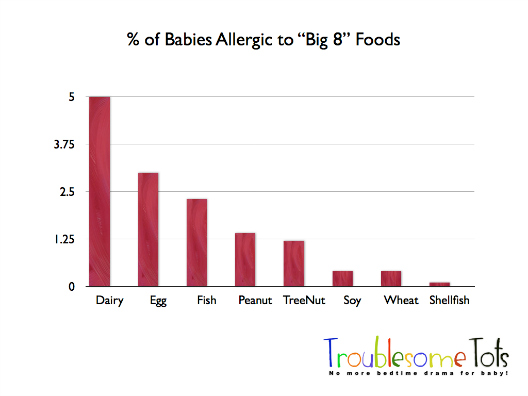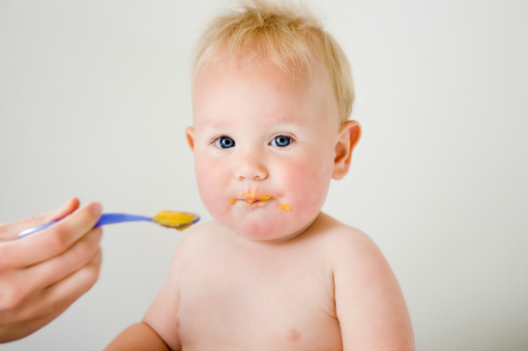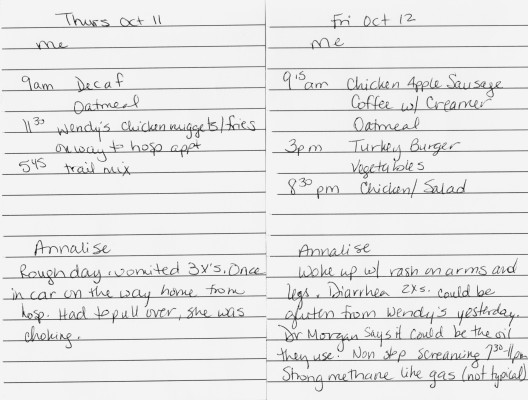[box type=”blank” class=”border-dashed2″]
This article is AMAZING. And I can say that because I didn’t write it. It’s everything you need to know if you think your child might have an issue with something in their (or your) diet. How to figure it out, what the likely culprit is, and how to manage it. It’s fantastic and resource-rich. If it’s too long to read on a screen, skip to the end and download the full PDF for saving, sharing, or printing.
[/box]
Hello sleepy peeps! My name is Lori DeMauro I am a Mom to a beautiful one-year-old daughter named Annalise who has quite a few feeding issues, to put it mildly, with one of them being food allergies. It’s one of the things I was really unprepared for as a new mom and I fumbled my way through, making mistakes along the way, and driving myself crazy staying up late (in the few minutes the baby actually was sleeping) trying to find answers online. But if there’s a positive to all of this, it’s that I’ve learned a lot about food allergies. And hopefully if I share what I’ve discovered it will save some of you the same frustration.
My daughter has an allergy or intolerance to each of the following: dairy, wheat, soy, eggs, and peanuts. She also may have celiac disease. The first symptoms of food allergies appeared when she was two weeks old, which is a really common time for symptoms to develop. At the time she was exclusively breastfed. She has had different reactions to different foods ranging from itchy red eyes to skin rashes to GI upset. This has made it very hard to determine what she was actually allergic to. I would research and take notes and think I had it all figured out and then eat something I thought was safe only to have her react. There are hidden ingredients everywhere. I have always been a health nut and habitual reader of food labels and I am a clinical researcher in my professional life so I thought I could take the knowledge I already had along with some quick research and be on my way.
[pullquote type=”1″ align=”center”]
It wasn’t nearly that easy.
[/pullquote]
With babies, you can never tell if a symptom is related to a food allergy or is just “normal baby stuff.” My daughter was born with several other health problems that compounded the issue with other symptoms. I could never tell which issue was causing which symptom or if they were all playing a role. In addition, being in the world we live in, there is actually too much information at our fingertips and I often found conflicting reports making. But there are some things we DO know.
Food Allergies in Babies
Food allergies occur in 5.1% of infants/children, up from 3.4% prior to 2011. 90% of all food allergies are related to what are known as the “Big-8”.That leaves 10% of food allergies related to “other things”, many parents report allergies to everything from corn to coconut.
The Big 8 Food Allergens
[list type=”checklist”]
- Wheat
- Soybeans
- Fish
- Shellfish
- Eggs
- Cow’s milk
- Peanuts
- Tree nuts
[/list]
While this list can seem a bit overwhelming (there is one or more of these ingredients in practically everything you enjoy eating) dairy (also known as Cow’s Milk Protein or CMP) is the most common with various studies suggesting that anywhere from 5-10% of infants having an allergic response.

How do you know if your baby has food allergies/intolerances?
Determining if your child has a food allergy or intolerance is extremely difficult. Statistically we know that ~95% of babies have no issue with food so the default assumption should be that your baby does not have an issue. Also numerous studies show that parents self-diagnose their children as having food issues 4X as often as they actually do. So chances are that diaper rash is just a diaper rash, and not an indication of something amiss with diet. But some babies do have food issues and conclusively determining if they have an allergy and what they’re reacting to is challenging. So how do you figure it out?
[pullquote type=”1″]
The best way to tell if your child is reacting to a food is to watch for symptoms.
[/pullquote]Testing isn’t reliable until at least one year of age and sometimes not even then. Babies do not make enough IgE (short for Immunoglobulin E), the antibody that reacts to allergens, to result in positive testing. If your child has a non IgE mediated allergy called Food Protein Induced Enterolcolitis Syndrome (FPIES), they would not test positive to an IgE skin test at any age. Often, physicians will suggest you wait anyway, as children outgrow many allergies by their first birthday and can continue to outgrow them throughout childhood. Therefore, you watch, you experiment (with physician guidance) and you wait. (I will address a bit more on testing later.)
Also your child can have an allergy or intolerance. A true allergy means that the body has an immune symptom reaction, it responds to the food as harmful and creates antibodies to fight it. Symptoms can range from mild itchy skin to anaphylaxis. A food intolerance often has the same symptoms as an allergy, but is when a certain food irritates the digestive system or can’t be easily digested, so the symptoms are typically digestive (bloating, cramps, diarrhea).
Symptoms of food allergies/intolerances in infants can be confusing and hard to discern from other typical baby ailments. These include:
[list type=”checklist”]
- Eczema
- Diarrhea
- Blood/mucous in stool
- Constipation
- Severe gas pain and/or stomach cramps
- Body and facial rashes
- Runny nose/congestion/cold like symptoms
- Hoarse voice
- Vomiting/Excessive Spit up
- Itchy/watery/red eyes
[/list]
But wait, aren’t most of these symptoms common to all babies? A hoarse voice and vomiting/spit up can be due to reflux, and most babies have eczema, lots of babies have constipation. So how do you know it’s a food allergy?
KEEP a FOOD/SYMPTOMS DIARY for you and/or your child (possibly both if you are nursing and your child is eating solid food). Be as detailed as possible, both in terms of what you/baby ate as well as any potential reaction. Make note of the time of day your baby ingested anything, whether its formula, breast milk, or solids. Then record physical symptoms and behaviors. Keep a diary for a couple of weeks and then look for trends. Without the diary, you are also likely to forget what you or they ate, or what happened. In addition, it is something you can show your pediatrician if you suspect an issue. Be sure to read labels of foods you eat if nursing or on formula/solid food packages. There is hidden dairy, gluten, corn, and soy in practically everything!
Symptoms can range from subtle to severe. Without the diary, you might overlook them or attribute them to general baby fussiness, that cold they got at daycare, teething, etc. The timing of reactions can be an indication of the type of response as well. Intolerances are going to reveal themselves over longer periods of time (via the gut) where a true allergy can cause a reaction within minutes to hours of ingesting a food (typically via skin, GI, and/or respiratory systems). Take vomit for example. If your child vomits and has swelling of the face quickly after eating a food, that indicates an IgE mediated allergy. If your child vomits severely and has diarrhea but not until several hours after ingesting a food, that indicates FPIES. FPIES vomiting can be so severe that it leads to dehydration or even shock. However if your child vomits a small amount hours to a day after ingesting a food and also has eczema or other GI symptoms, this indicates an intolerance.
Sample Food Log
If, after consulting with your pediatrician and possibly a pediatric allergy specialist, you feel confident that your child has a potential food allergy or intolerance, you’ll need to start cutting those foods out of your child’s and if you’re nursing, your diet. Seems simple enough but in fact can be an enormous challenge. Allergens are hidden in just about everything you eat, infant formula, ready-made baby food, etc.
If you’re looking for practical advice on how to safely navigate food allergens (for both breastfed and formula fed babies) keep reading on the next page (click link below).

